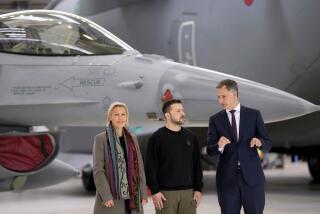Will We Rule the Skies?
- Share via
NATO and the United States completed a victorious air campaign in Yugoslavia. As in Desert Storm, almost a decade earlier, the conditions for victory were set because we owned the sky: We had air superiority. Air superiority is not just control of an enemy’s aircraft; it is domination of all an enemy’s air capabilities--command and control, communications, radar, surface-to-air missiles, airfields, munitions and infrastructure. Air superiority is the state of military air affairs that provides freedom from attack and freedom to attack, not just for air forces, but for land and naval forces as well.
In Desert Storm, the conditions were set by air superiority for land forces to succeed in fewer than 100 hours. In Kosovo, conditions were set for victory without having to use land forces in battle. Not since early World War II have American fighting forces been subjected to intense aerial attack. In the early 1970s, we began producing the F-15 aircraft to ensure air superiority for all our forces. That was more than a quarter of a century ago, and the F-15 is wearing out--both physically and technologically.
Plus, there are aircraft being produced today that match or exceed the F-15’s capability. And they are for sale worldwide to potential adversaries. In the recent Balkan conflict, we lost two aircraft to 1970s’ generation surface-to-air missiles. One of the aircraft lost was an F-117--our first generation of stealth aircraft.
Additionally, a whole new generation of surface-to-air missiles is for sale worldwide. These weapons pose a serious threat to all of our current conventional aircraft. The one aircraft capable of dealing with these serious challenges to future air superiority is the F-22 Raptor. The F-22 employs the latest stealth technology and can cruise at supersonic speed and attack critical ground targets and aircraft deep in dangerous territory. Neither a retread F-15 nor the economy-class Joint Strike Fighter are sufficient to that task. That’s why the Air Force has diligently designed and tested this aircraft. In fact, when compared to the F-15, F-16 and F-18, the F-22 has already completed more flight test time than any of the other three aircraft at their production decision points. The F-22 has spent almost twice as long in development as the F-18, and three times as long as the F-15, giving us valuable time to properly design the aircraft. This careful planning and execution has paid off; the F-22 has passed its tests with flying colors and is ready for production.
That’s why it was such a surprise when the House Appropriations subcommittee summarily removed production funding for the F-22. Secretary of Defense William S. Cohen has called the F-22 “the cornerstone of our nation’s air power in the 21st century.” In our nation’s conflicts, we will be asked to lead the fight into the heart of the enemy’s air defenses, to ensure air superiority for our soldiers, sailors, Marines and Air Force personnel. We will be asked to own the sky; we should not ask our aviators to do it with anything but first-rate equipment. That’s the F-22 Raptor.
More to Read
Sign up for Essential California
The most important California stories and recommendations in your inbox every morning.
You may occasionally receive promotional content from the Los Angeles Times.













